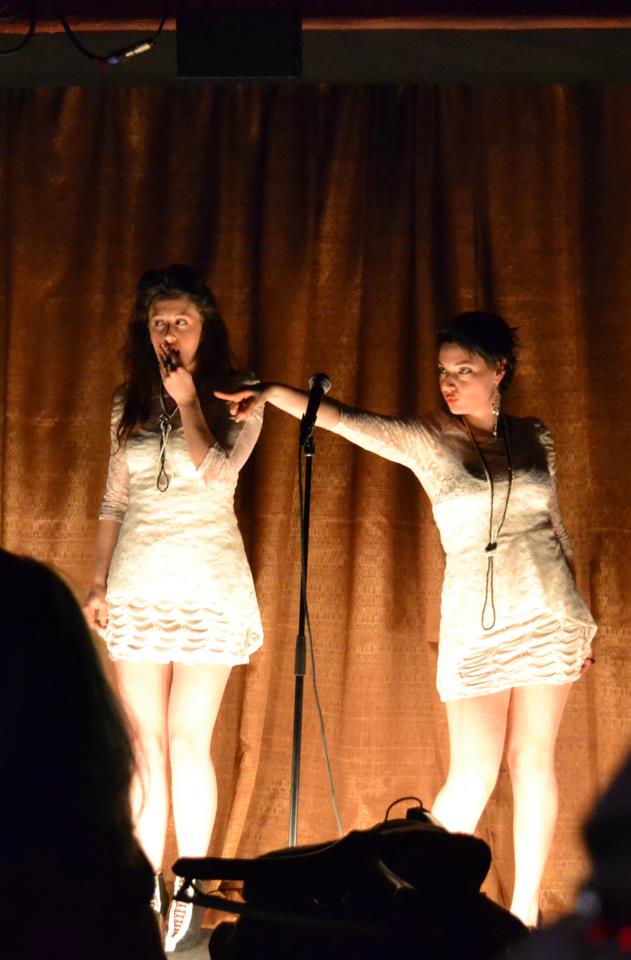The Bird Bath, the latest show at the Yale Cabaret, like the show the previous week, was developed entirely by YSD students and treats the theme of mental illness. Directed by Monique Barbee and created by an ensemble of three women—Chasten Harmon, Hannah Leigh Sorenson, Ariana Venturi—who enact three different aspects of the British-born surrealist painter Leonora Carrington, the play is set, more or less, in an asylum. The drama is in how the three actresses pantomime the artist’s states of psychic duress. For Carrington, apparently, the trinity explained everything, so the set consists of three separate areas: the one to our left seems neat and methodical, somewhat like a lab, somewhat like a writer’s workroom; the central space consists primarily of a very graceful bathtub and curtain; the area to our right contains a bed with an old metal frame. Each space is decorated with interesting objets d’art. White is the predominant non-color.
At left and right, respectively, Venturi and Harmon enter through the windows, climbing in to take up residence shortly after Sorenson, in the center, ceases vomiting into a large bucket. This opening tableau—a woman crouched on the side of a tub attempting to spit up by drinking quantities of orange blossom water—goes on for a bit, while the actress’s voice-over speaks lines derived from Carrington’s book about her treatment in a mental institution after a breakdown.
In other words, the show establishes early its intent to give us a visceral experience of physical distress, but such discomfort is offset by an enthralling series of tableaux vivants that work because of the rigorous physicality of the actresses and the wonderful set design (Mariana Sanchez Hernandez) and lighting (Masha Tsimring) and music/sound (Palmer). Each actress is mostly contained in a setting that becomes her entire world, a space, we might suppose, that is an external manifestation of Carrington’s internal state. The three aspects are distinct enough, if somewhat obvious.
Simply, we can see the left-side figure (Venturi) as Carrington attempting to maintain her intellectual and artistic bearings, often clutching a lab jacket to her throat or at times crushing an egg while the other figures convulse; the right-side figure (Harmon) presents the more animal, bodily passions—Harmon moves often in a crouch and at one point enacts an animal defecating, then nosing its feces, while at other times, with a lemon in her mouth, she grips the bed and shakes like someone undergoing shock treatment; the central figure (Sorenson) bathes and primps, convinced she is Queen Elizabeth, and at other times writhes on the floor. This figure, we might suppose, is the spirit, or at least the spirit as manifested in the artist’s creativity in combat with her own delusions. Sorenson does a quite spectacular job of both embodying the kind of feminine principle that a male artist might use to represent beauty or spirit, while also giving us the frantic, quivering flesh of a female artist grappling with her demons. It’s stunning physical theater.
Carrington, the notes by Dramaturg Sheria Irving, tell us, “was treated with Cardiazol, a drug . . . that induced convulsions and hallucinations.” Just the thing for a surrealist, we might suppose. And one of the tensions The Bird Bath seems to want to explore, as did Jackson’s All This Noise last week, to some extent, is the relation between artistic self-conceptions and mental illness. The idea that madness is a form of creativity is very old, and the idea that truly creative spirits, in their innovation, might be taken for insane is also prevalent at times. Carrington herself seems to have shared some of those notions—as did other surrealists—and so the play might be said to culminate with each of the three women creating an effigy or bust that might be a way of externalizing her anxieties.
Venturi and Harmon create constructions that could be entered as found objects in a Duchampian display. But Sorenson’s Carrington becomes an effigy herself. In the best sequence in the play, she puts a latex mask over her head, powders it white and draws a red mouth on the powdered mask over her lips. “Eyeless in Gaza,” so to speak, she becomes an image of the surrealist muse, perhaps, a figure out of Man Ray, that is also the artist as abject heroine of her own life.
Three, of course, is the number of the Graces, the Fates, and the Furies, in Greek myth. These three women, together with their director, set-up a tripartite tableau of the mind and soul of a figure sorely tried by her own mind and by a drug that invades her body and causes terrors and trauma. In the end there’s a glimpse of expressive grace—Sorenson, wet and half naked, leaning out three sets of windows, successively, as though gulping the air of freedom and relief—before the fury resumes again.
We might suppose that’s the best we can hope for.
The Bird Bath Created by Ensemble Directed by Monique Barbee
Dramaturg: Sheria Irving; Scenic Designer: Mariana Sanchez Hernandez; Lighting Designer: Masha Tsimring; Sound Design & Original Music: Palmer; Stage Manager: Alyssa K. Howard; Producer: Emika Abe
Yale Cabaret 217 Park Street
February 28-March 2, 2013
